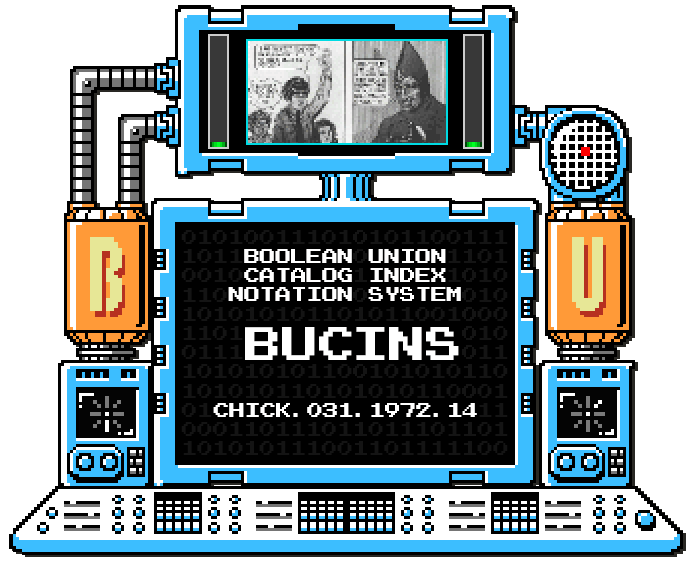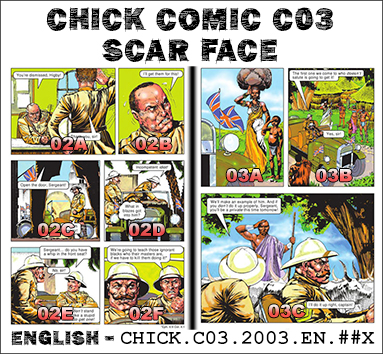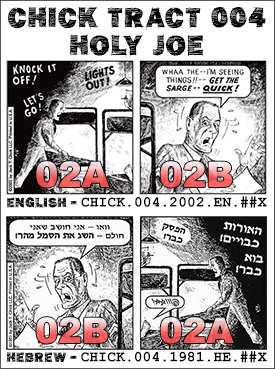 Introduction ⇑ ⇓
Introduction ⇑ ⇓ 
There are a wide variety of catalog schema employed by academics, researchers, collectors and various other individuals to archive and discuss a particular corpus of published works. One of the most widely known in the United States is the Dewey Decimal System, utilized by numerous libraries therein and which forms the basis of the Universal Decimal Classification System used for much the same purpose elsewhere in the world. When it comes to comic books, the fan communities of different publishers and series frequently develop specialized systems individualized to those particular works, and those works covered by this website are certainly no exception.
While numerous attempts have been made to develop a unified system to catalog those works released by Chick Publications over the years, including those proposed by Fowler, Kursteiner and others; no single system has been able to account for all the numerous peculiarities present in Chick's history of publication, nor has yet to achieve a plurality of acceptance over another. As the works of other writers in addition to Jack Chick are also covered by this website, we have likewise attempted to develop such an indexing system to better organize those books and comics relevant to our research.
Referred to as a BUCINS (boō sinz) code, the notation system employed by the Boolean Union seeks to incorporate the most relevant portions of these preceding systems in a practical, unifying manner. The general syntax of a BUCINS code is as follows:
[Publisher].[Title].[Year].([Language]).[Page/Panel]
e.g. CHICK.001.1970.EN.03A
 Publisher ⇑ ⇓
Publisher ⇑ ⇓ 
The first portion of the code consists of a five letter indicator to distinguish the publishers of the specific work being referenced. The current list of these as used by the Boolean Union are shown in Table 1:
Table 1: Publisher Codes| BUCINS Designation | Publisher |
|---|---|
| CHICK | Chick Publications |
| DANNS | “Chaplain” Dann Slator |
| TTODD | Tim Todd (Revival Fires Ministries) |
| SPIRE | Spire Christian Comics (Al Hartley) |
| WHEEL | Ron Wheeler |
| CARCH | Catholic Archdiocese of New York |
| HAFER | Dick Hafer |
| LIFEM | Life Messengers |
| GDSND | Godsend - Spiritual Warrior |
| LOKMN | Vic Lockman |
| CPOBB | Christian Publicity Organisation |
| BRAVE | Brave Books |
| OTHER | Other Works |
| KNGST | Kingstone Comics |
 Title ⇑ ⇓
Title ⇑ ⇓
The next section of the code references the specific published piece. This would be the individual tract, book, comic, pamphlet, etc. being discussed. When referencing the tracts or comic books issued by Chick Publications, either the four letter designation established by Robert Fowler[A] (Fowler Code) or the three digit number used by the Jack Chick Museum of Fine Art may be used. For example, the following codes would all be considered valid and would each refer to the leftmost panel on the third page of the 1970 edition of the first tract published by Jack Chick, Why No Revival? ("Christians of Yesterday!" panel):
CHICK.001.1970.03A
CHICK.WHYN.1970.03A
As Fowler's seminal work was published in 2001, prior to the release of a number of later Chick tracts and comics, we have endeavored to create comparable codes for these later works ourselves using a similar methodology. Additionally, there were several tracts which were “officially” re-released with significantly modified art or under new titles, but which maintained most or all of the same plot points and/or text. These new editions were issued completely different Fowler Codes to reflect their new titles, but when addressed by their release numbers, those numbers are appended with a letter. The Chick tract This Was Your Life! was originally drawn by Jack Chick himself and featured a man who dies and is shown a recounting of the events of his entire life while undergoing divine judgment. This same tract was later redrawn by Fred Carter to feature an African man instead (It’s Your Life!) as part of their Black Tract Series, then again by Chick to feature a Caucasian woman (You Have a Date!), then again by Carter to star an African woman (Your Big Moment), and finally again by Chick with a Middle-Eastern/Muslim gentleman (Your Best Life). Each of these versions has a distinct Fowler/Boolean Union code, but as they are essentially “re-skins” of an already released tract, the “tract number” assigned to each would still be that of the original tract (003) with a letter included to denote release order. The table below (Table 2) shows the BUCINS Codes for the above example...
Table 2: BUCINS Codes for Tract #003 and associated rereleases| Title | Tract # | Fowler / BU Code | Publication Year | BUCINS Code |
|---|---|---|---|---|
| This Was Your Life! | 003A | TWYL | 1964 | CHICK.003A.1964 or CHICK.TWYL.1964 |
| It's Your Life! | 003B | ITYL | 2006 | CHICK.003B.2006 or CHICK.ITYL.2006 |
| You Have a Date! | 003C | YHAD | 2011 | CHICK.003C.2011 or CHICK.YHAD.2011 |
| Your Big Moment | 003D | YBGM | 2011 | CHICK.003D.2011 or CHICK.YBGM.2011 |
| Your Best Life | 003E | YBTL | 2014 | CHICK.003E.2014 or CHICK.YBTL.2014 |
 Year ⇑ ⇓
Year ⇑ ⇓
Endemic to Chick’s work is the re-release of previous publications, sometimes with minor (and occasionally major) modifications to the art, content or even title. The inclusion of the copyright/publication year in the code is to differentiate earlier editions of a particular title from later releases or revisions. A number of Chick’s publications also had re-releases which changed the contents of the title without a subsequent update to the publication year listed. In circumstances such as these, we append the year with a letter to categorize these pieces in approximate release order as can best be determined. For example, the 1992 edition of the tract The Last Generation was modified to correct minor spelling mistakes and to make slight alterations to alleviate continuity errors from previous releases. However, both of these versions bear the copyright date “1992”. We have classified these as CHICK.031.1992A and CHICK.031.1992B respectively.
 Language (Optional) ⇑ ⇓
Language (Optional) ⇑ ⇓
Most of the works handled by Boolean Union were originally published in English. However, some works saw translations into other languages to boost their accessibility and reach. This is especially true of a number of Chick’s tracts, of which a particularly egregious example is (again) This Was Your Life! Over the years, this tract has seen translations into over 100 different languages including Spanish, German, Fijian, Blue Hmong, Hiligaynon, Waray-Waray and numerous others. Some of these translations (such as the aforementioned Waray-Waray and Fijian versions) involved numerous changes, (both subtle and overt) to the art as well as the text.
While the language portion of the BUCINS is optional, it should be included when referring to a version of a work in any language other than English. If the language portion is omitted from the code, it can be assumed to be referring to the original (English) edition of the work. Languages are indicated using either the two or three letter codes established in the ISO 639-1 Code standards. Thus, the full BUCINS codes for the language variants mentioned above would be as follows…
Table 3: Language Codes for variants for Tract #003 and associated rereleases| Language | BUCINS Code |
|---|---|
| Spanish | CHICK.003A.2001.ES |
| German | CHICK.003A.2002.DE |
| Fijian | CHICK.003A.2000.FJ |
| Blue Hmong | CHICK.003A.1996.HNJ |
| Hiligaynon | CHICK.003A.2022.HIL |
| Waray-Waray | CHICK.003A.2001.WAR |
 Page / Panel ⇑ ⇓
Page / Panel ⇑ ⇓
Utilizing a consistent methodology is vital should one wish to discuss or compare specific images or portions of text between different works (or between different editions of the same work). An idiosyncrasy unique to Chick tracts is that, unlike standard comic books, the outside of the front cover is considered to be “Page 1” with the inside of the front cover being “Page 2” and so on through the outside of the back cover typically being labeled “Page 24” owing to the standard chick tract containing 18 internal “pages” plus both sides of the cover. To maintain standardization, this is a practice we have also adopted when discussing publications by other authors, including full-sized, more “traditional” comic books.
Comic pages are most typically segmented into individual images, or “panels” and when referencing a specific image, all panels are denoted with a letter added to the page number and progressing from left to right, and top to bottom on the page. See the following illustrations…
The only exception to this would be variations of works published in languages which do not follow the typical western convention and instead are read from right to left such as Japanese, Hebrew, etc. When denoting individual panels in these editions, the panel lettering is mirrored accordingly. For example…
 References ⇑
References ⇑
- #[A]⇑ The World of Chick? by Robert Fowler (2001).
(https://www.biblio.com/9780867195125)





